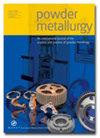用监督和无监督机器学习研究用于激光粉末床熔合的水雾化工具钢粉末的流变特性
IF 1.9
4区 材料科学
Q2 METALLURGY & METALLURGICAL ENGINEERING
引用次数: 0
摘要
摘要:为增材制造工艺开发的金属粉末需要达到特定的流动特性才能被认为是合适的。然而,由于粉末流动与单个颗粒的形态特征之间的关系可能很难建立。在这种情况下,人工智能似乎是澄清这种互动不精确性的完美工具。本文中总结的工作首先使用神经网络架构(Mask R-CNN),允许在扫描电子显微镜中获得的显微照片中分割单个水雾化工具钢颗粒。然后,使用并比较两种不同的策略,即线性回归或无监督机器学习(ML),对单个颗粒或其形状描述符的显微照片进行处理,以将收集到的单个颗粒的信息与粉末样品的流变特性相结合。所开发的方法旨在获得有关特定颗粒特性的新知识,这些特性是优化激光粉末床融合粉末流动性所需的。本文章由计算机程序翻译,如有差异,请以英文原文为准。
Rheological characterisation of water atomised tool steel powders developed for laser powder bed fusion by supervised and unsupervised machine learning
ABSTRACT Metal powders developed for additive manufacturing processes need to achieve specific flow characteristics to be considered suitable. However, for the relationship between powder flow and the morphological characteristics of individual particles can be difficult to establish. In this context, artificial intelligence appears to be the perfect tool to clarify the imprecision surrounding this type of interaction. The work summarised in this manuscript first uses a neural network architecture (Mask R-CNN) allowing the segmentation of individual water-atomised tool steel particles in micrographs acquired in scanning electron microscopy. The micrographs of individual particles or their shape descriptors are then processed using and comparing two different strategies, namely linear regression or unsupervised machine learning (ML), to corelate the information collected on individual particles with the rheological properties of powder specimens. The approach developed aims to acquire new knowledge regarding specific particle characteristics that are required to optimise powder flowability for laser powder-bed fusion.
求助全文
通过发布文献求助,成功后即可免费获取论文全文。
去求助
来源期刊

Powder Metallurgy
工程技术-冶金工程
CiteScore
2.90
自引率
7.10%
发文量
30
审稿时长
3 months
期刊介绍:
Powder Metallurgy is an international journal publishing peer-reviewed original research on the science and practice of powder metallurgy and particulate technology. Coverage includes metallic particulate materials, PM tool materials, hard materials, composites, and novel powder based materials.
 求助内容:
求助内容: 应助结果提醒方式:
应助结果提醒方式:


